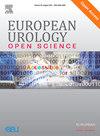Development and Validation of an Algorithm for Segmentation of the Prostate and its Zones from Three-dimensional Transrectal Multiparametric Ultrasound Images
IF 3.2
3区 医学
Q1 UROLOGY & NEPHROLOGY
引用次数: 0
Abstract
Background and objective
Multiparametric ultrasound (mpUS) is being investigated as an alternative to magnetic resonance imaging (MRI) for detection of prostate cancer (PC). Automated prostate segmentation facilitates workflows, and zonal segmentation can aid in PC diagnosis, accounting for differences in imaging characteristics and tumor incidence. Our aim was to develop a deep learning algorithm that can automatically segment the prostate and its zones on three-dimensional (3D) contrast-enhanced ultrasound (CEUS) and conventional brightness-mode (B-mode) images (NCT04605276).
Methods
A total of 259 3D mpUS images were collected from men with suspicion for PC in a prospective multicenter trial to develop a computer-aided diagnosis system for PC. Manual segmentation was performed using a custom tool, and an algorithm was developed using a convolutional neural network based on the U-Net architecture.
Key findings and limitations
Cross-validation of the automated segmentation algorithm revealed Dice similarity coefficients (DSCs) of 0.91 (95% confidence interval [CI] 0.90–0.91) for CEUS and 0.94 (95% CI 0.93–0.94) for B-mode ultrasound for 3D prostate segmentation. Zonal segmentation was less accurate, with DSCs of 0.83 (95% CI 0.82–0.84) for CEUS and 0.86 (95% CI 0.85–0.87) for B-mode ultrasound. There was high agreement for prostate volume between automatic segmentation on CEUS and physician-estimated volumes on MRI (R2 = 0.96). Qualitative assessment of prostate segmentation using a scale from 1 to 5 revealed a median grade of 5 (interquartile range [IQR] 4–5) for manual segmentation and 4 (IQR 4–5) for automated segmentation (p = 0.10).
Conclusions and clinical implications
Our deep learning algorithm demonstrated strong performance for automatic prostate and zonal segmentation from 3D CEUS and B-mode ultrasound images.
Patient summary
We developed a computer tool to automatically identify the prostate in three-dimensional ultrasound images. The results show high accuracy and closely match manual assessments by urologists. This tool has potential for use in a computer-aided diagnostic system for prostate cancer.
从三维经直肠多参数超声图像中分割前列腺及其区域的算法的开发和验证
背景与目的多参数超声(mpUS)作为磁共振成像(MRI)检测前列腺癌(PC)的替代方法正在被研究。自动前列腺分割简化了工作流程,分区分割可以帮助诊断PC,考虑到成像特征和肿瘤发生率的差异。我们的目标是开发一种深度学习算法,该算法可以在三维(3D)对比增强超声(CEUS)和传统亮度模式(b模式)图像(NCT04605276)上自动分割前列腺及其区域。方法采用前瞻性多中心临床试验,收集259张疑似PC男性的三维mpUS图像,开发PC计算机辅助诊断系统。使用自定义工具进行人工分割,并使用基于U-Net架构的卷积神经网络开发算法。自动分割算法的交叉验证显示,超声造影的Dice相似系数(dsc)为0.91(95%可信区间[CI] 0.90-0.91), b超三维前列腺分割的Dice相似系数(dsc)为0.94 (95% CI 0.93-0.94)。区域分割较不准确,超声造影的dsc为0.83 (95% CI 0.82-0.84), b超的dsc为0.86 (95% CI 0.85-0.87)。超声造影自动分割的前列腺体积与医生估计的MRI体积高度一致(R2 = 0.96)。使用1到5的量表对前列腺分割进行定性评估,结果显示手动分割的中位评分为5(四分位数范围[IQR] 4 - 5),自动分割的中位评分为4 (IQR 4 - 5) (p = 0.10)。结论及临床意义我们的深度学习算法在三维超声造影和b超图像的前列腺和区域自动分割中表现出较强的性能。我们开发了一种计算机工具,可以在三维超声图像中自动识别前列腺。结果显示准确度高,与泌尿科医生的人工评估结果非常吻合。该工具有潜力用于前列腺癌的计算机辅助诊断系统。
本文章由计算机程序翻译,如有差异,请以英文原文为准。
求助全文
约1分钟内获得全文
求助全文
来源期刊

European Urology Open Science
UROLOGY & NEPHROLOGY-
CiteScore
3.40
自引率
4.00%
发文量
1183
审稿时长
49 days
 求助内容:
求助内容: 应助结果提醒方式:
应助结果提醒方式:


